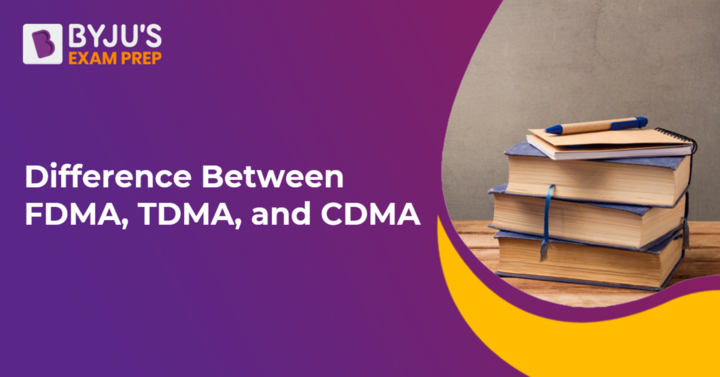Difference Between FDMA, TDMA, and CDMA | FDMA VS TDMA VS CDMA
By BYJU'S Exam Prep
Updated on: September 25th, 2023
FDMA stands for frequency division multiple access, TDMA stands for time division multiple access, and CDMA stands for Code Division Multiple Access. These are modes of data transmission and communication. Here, we have discussed about FDMA, TDMA, CDMA, and the difference between FDMA, TDMA, and CDMA.
Difference Between FDMA, TDMA, and CDMA PDF
The difference between FDMA, TDMA, and CDMA is that In FDMA, transmission happens via a constant signal. In TDMA, transmission happens in bursts through signals. However, in CDMA, digital signals are used during transmission. Let us check the difference between FDMA, TDMA, and CDMA in the sections below.
Table of content
Difference Between FDMA, TDMA, and CDMA
The difference between FDMA, TDMA, and CDMA are mentioned in the table below.
|
FDMA vs TDMA vs CDMA |
||
|
FDMA |
TDMA |
CDMA |
|
This involves the sharing of bandwidth across various stations. |
Only the sharing of satellite transponder time occurs in this. |
The sharing of both bandwidth and time among the several stations occurs in this. |
|
A codeword is not required for the FDMA. |
TDMA also needs no codeword. |
In the case of CDMA, the codeword is a required. |
|
There is no need for synchronisation with FDMA. |
TDMA needs to be synchronised. |
Furthermore, CDMA doesn’t need synchronisation. |
|
In FDMA, transmission happens via a constant signal. |
Through signals, transmission happens in bursts. |
Digital signals are used during transmission. |
|
Data rate is low. |
Data rate is medium. |
Data rate is high. |
|
There is a relatively small cell capacity for FDMA. |
TDMA has relatively little cell capacity. |
CDMA does not have any channel capacity restrictions, it is interference-limited. |
|
FDMA is reliable, well-known, and relatively straightforward. |
TDMA is well-established, completely digital, and versatile. |
In addition to being flexible and requiring less frequency planning, CDMA also provides a milder signal handover. |
What is FDMA?
The full form of FDMA is frequency division multiple access. It divides the radio frequency (RF) channel it has available into several sub-channels (smaller). As an illustration, two 6.5 kHz sub-channels are created from a single FM channel that was previously only capable of carrying one conversation and is 13 kHz wide in narrowband. This method, which works with both analogue and digital radio transmissions, is not particularly novel. If one uses one channel for signal transmission and one channel for signal reception, one can also conduct a telephone-style conversation.
- Create distinct subbands by dividing the frequency spectrum.
- Every terminal has an uninterrupted frequency of its own.
- Utilising frequency domain filtering.
- Because frequencies are a limited resource, FDMA is rigid.
- Limited cell capacity exists.
- Lower power effectiveness.
What is TDMA?
The full form of TDMA is Time Division Multiple Access. Instead of dividing its main RF channel into two or more subchannels, TDMA divides it into two-time slots. Even though each slot uses the same RF frequency, it may accommodate individual talks in each of them. For instance, if the main channel breaks into four-time slots, they will need to transmit the desired data and information in 25% less time than before.
- Demand-driven or governed by set patterns, segments send time into separate time periods.
- Each terminal uses the same frequency for brief bursts of activity.
- Synchronisation of events in time.
- TDMA was founded and is totally digital and versatile.
- Limited cell capacity exists.
- Full power efficiency is possible while using TDMA.
What is CDMA?
The full form of CDMA is Code Division Multiple Access. Instead of dividing the original RF channel into two or more time slots or sub-channels, CDMA gives each one a separate code. In contrast to FDMA, CDMA transmits at exactly the same frequency during each slot. Additionally, CDMA transmits individual slots simultaneously, in contrast to TDMA.
- Each terminal can operate uninterruptedly at the same time and location.
- Signal separation for unique receivers for coding pulses.
- Because CDMA requires less frequency, soft handover is possible.
- Given the complexity of the CDMA receiver, senders must use more complex power management.
- There is no absolute maximum on channel capacity. However, a system is limited by interference.
- Full power efficiency is possible while employing CDMA.



